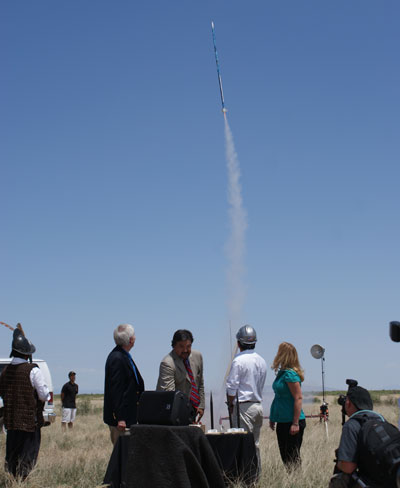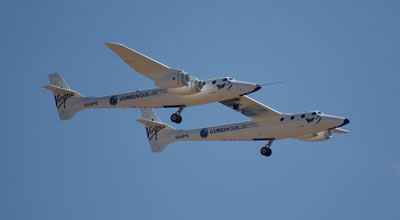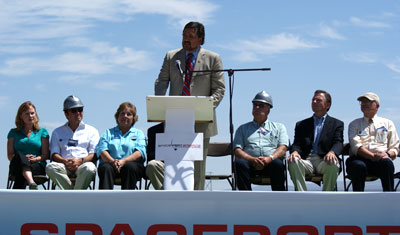Launching a spaceportby Jeff Foust
|
| The spaceport might become the site from which thousands get to experience space, but for many in the region the bigger interest is in the thousands of jobs the facility may generate. |
That theme—the spaceport as an engine of regional economic development—permeated the two days’ worth of events surrounding the groundbreaking, including public events in the cities of Las Cruces and Truth or Consequences and the actual groundbreaking itself on the site of the spaceport, attended by nearly 500 invited guests and media members bused into the remote site on a road completed just days earlier. After nearly two decades of effort, Spaceport America was finally on the verge of delivering on what its backers had promised.
“One of the main reasons we worked so hard to build it [the spaceport] in southern New Mexico is because of education, because of kids, and jobs, and science and math for young kids, who will hopefully think of becoming engineers and astronauts,” New Mexico governor Bill Richardson said in a public event on the campus of New Mexico State University in Las Cruces the evening before the groundbreaking. “We can have thousands of jobs in technology and science and renewable energy research and space, commercial space.”
The focus on jobs would be understandable in any part of country given the current economic climate, but it was a cornerstone of the efforts to win public support for the facility, including the passage of tax increases in referenda in two counties in southern New Mexico, long before the current recession. The lack of high-technology high-paying jobs in the region has led to a brain drain where the best and brightest have moved elsewhere to find employment, something that backers hope the spaceport can reverse.
“As a native Las Crucesan, I have a number of friends from Las Cruces High School and the surrounding high schools who have ventured outside of the state for employment,” said Daniela Glick, deputy secretary of the state’s economic development department and chairwoman of the New Mexico Spaceport Authority. “They will now have the opportunity to stay close to home and work with cutting-edge technology.”
“I see the future of young kids, men and women, in Doña Ana County”—where Las Cruces is located—“being the ones who get those high-paying jobs at the spaceport,” Richardson said.
 Gov. Richardson presses a button to launch an amateur rocket as (from left) FAA associate administrator George Nield, Virgin Galactic president Will Whitehorn, and New Mexico Spaceport Authority chairwoman Daniela Glick look on. (credit: J. Foust) |
A delayed guest of honor
The groundbreaking events were more than just speeches about jobs, education, and economic benefits. Friday’s groundbreaking was started with a ceremonial processing of “explorers of the past”—people dressed up as Spanish conquistadores and settlers, who marched in from a field behind the stage in a scene reminiscent of the one in the movie Field of Dreams when the ballplayers emerged from among the rows of corn on Ray Kinsella’s farm. That immediately brought to mind another parallel, namely, the movie’s signature line: “If you build it, he will come.” In this case, “it” was the spaceport and “he”, presumably, was Richard Branson and his space tourism venture, Virgin Galactic. (Branson wasn’t present, but two top Virgin Galactic officials, president Will Whitehorn and CEO Stephen Attenborough, were there.)
The actual groundbreaking was carried out by an industrial grader, which plowed a path behind the stage after the completion of a series of speeches. Then Richardson, Whitehorn, and other dignitaries scooped spoonfuls of dirt into a container that was then poured into the nosecone of a small amateur rocket that was launched: a bit of symbolism for launching the spaceport, even if the rocket traveled only to a few thousand feet altitude.
The groundbreaking ceremony, though, was just that—ceremonial. Some final work remains on the road leading to the spaceport site to allow heavy machinery to use it, Steve Landeene, executive director of the spaceport authority, said afterwards. There was also some final archeological work on several cultural sites on the spaceport property that needed to be completed to ensure that they would not be disturbed when construction began. He predicted that by mid to late July construction would begin in earnest on the spaceport’s runway.
| Landeene predicted that by mid to late July construction would begin in earnest on the spaceport’s runway. |
One highly-anticipated guest was missing from the ceremonies. Speaking at the International Space Development Conference last month in Orlando, Whitehorn said that Virgin Galactic planned to have the WhiteKnightTwo (WK2) aircraft fly over the groundbreaking ceremonies, assuming the aircraft’s test program, as well as weather conditions, permitted. By the day of the groundbreaking both conditions appeared to have been met: WK2 had completed nine test flights, and the weather in New Mexico was mostly sunny. At a public event in Truth or Consequences shortly before the groundbreaking event, Attenborough announced that WK2 had taken off from Mojave Air and Space Port in California, en route to the spaceport site.
However, Whitehorn broke some bad news at the end of his speech at the groundbreaking. “Today on flight 10 at 47,000 feet, the pilot saw an actuator light go on, and they have decided, as a matter of pure precaution, to land at Phoenix to check the plane,” he said. “That’s normal in a test program. So it’s not going to be here shortly, but they’re hoping to come here later on in the day, or if not, tomorrow.”
“So I do apologize that you won’t be seeing WhiteKnightTwo in the next hour and a half, but that doesn’t matter to us because we know it’s capable of doing the job it’s going to do,” Whitehorn continued. “It’s early in its test flying program; it’s only flight 10. We’re planning over 200 flights in the program; a bigger test program than Concorde had, because we are going to make sure that no one gets in that plane—commercially, scientifically, or industrially—unless it’s going to be 100 percent safe for them, 100 percent safe within the terms that we can be able to provide in the future.”
 WhiteKnightTwo flies over Las Cruces International Airport on the morning of June 20. (credit: J. Foust) |
Whitehorn did provide a bit of news about the test program during a brief Q&A session after the end of the ceremonies. “We’ll be flying the WhiteKnightTwo and the spaceship together in December, and we’ll be starting the spaceship flights by themselves in the second part of next year, beginning the process of taking the spaceship into space with its rocket motor firing,” he said. (At a VIP reception the night before, Whitehorn was more specific, saying that SpaceShipTwo would be “unveiled and flown for the first time” on December 7.)
There was, though, a consolation prize for those who stuck around an extra day. Late Friday Virgin Galactic and Spaceport America announced that the problem that caused WK2 to divert to Phoenix-Mesa Gateway Airport had been resolved, and that the aircraft would instead fly over the city of Las Cruces, including several low passes of the city’s airport, Saturday morning at 9:30 am. And WK2 did indeed turn up at that time, providing a dazzling display for the few dozen people able to make it out to the airport on short notice. It was, perhaps, an analogy for the development of the spaceport itself, which has taken longer than anticipated for work to begin but, like WK2, had finally come through. How well either the aircraft and its accompanying spacecraft, or the spaceport it plans to operate from, will live up to its potential in something the space industry, and the people of southern New Mexico, will be watching closely over the next few years.
